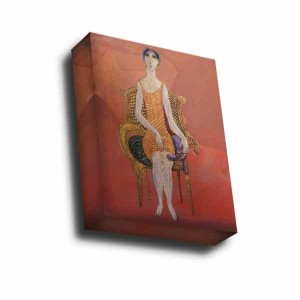 Canvas photo prints are a hot item right now, with services popping up promising to transform your digital photograph into a wall-worthy piece of canvas art. Here’s what you need to know about canvas prints:
Canvas photo prints are a hot item right now, with services popping up promising to transform your digital photograph into a wall-worthy piece of canvas art. Here’s what you need to know about canvas prints:
Why Canvas? Sometimes you want your photos to create an impression. Canvas prints are perfect for that – not simply because they’re typically large (you can blow up a traditional photo print to similar sizes) but because the way canvas reflects light and the impression it tends to leave on the viewer. Since antiquity, we’ve associated “canvas” with “art” and even if you don’t think your photographic skills merit such a weighty term, printing your photos on canvas lends a certain gravitas.
Size & Price: A canvas print can be ordered in sizes usually starting at 8 x 10-inches up to 40 x 60-inches. You can make a larger print by creating blocks – a single photo divided into three or more distinct prints (you can produce this “block” effect with smaller-sized prints as well). The size of the print is determined by your photo’s resolution – if you have a high resolution digital camera (one that snaps about 7-megapixels photos or higher), you should be able to order a larger canvas print in the 30 x 40-inch range. If you have an older digital camera with a lower resolution, you’ll be limited to smaller sizes.
The size of your canvas print will determine its price – with larger prints being pricier. But there’s more to the price than canvas print size, such as whether you order the print in “rolled” of “framed” format.
Rolled vs. Framed or Stretched: A “rolled” canvas is a photo print that’s not stretched out over (or placed beneath) a frame. It’s less expensive to order a rolled canvas print, since the printer won’t have to stretch and frame the canvas themselves. But that’s mean you’ll have to handle that job. A “stretched” canvas is a print that’s flattened out and anchored around a wooden frame. You can still frame a stretched canvas, as a stretched canvas is usually wrapped over a wooden frame, obscuring it from view. It’s more expensive to purchase a stretched canvas.
 Image courtesy UPrinting
Image courtesy UPrinting
Where Can You Make a Canvas Print? The short answer is: at many of the places you order traditional photo prints or merchandise, including retail locations and online providers. Wal-Mart, for instance, offers a selection of canvas products starting with a tiny 4 x 6-inch “easel” print for $13 up to a 24 x 36-inch canvas for $80. Specialty printers like Canvas Pop, Your Photo on Canvas, and Best Canvas, offer a much wider selection and greater options when it comes to framing and presentation. You’ll also get the benefit of professional retouching and the option to add creative effects, such as giving your photo the look of an oil painting.
Can You Make Your Own Canvas Print? Short answer: yes. There are two ways to do it. The first is to print directly to canvas media on your home inkjet printer. Canvas paper is sold in both sheet and roll forms, but you can’t just drop some canvas sheets into any inkjet printer and expect good results. Canvas paper is thicker than your average photo paper and could get stuck in your home printer if you’re not sure your printer will accept it. How to tell? Most printers will indicate on their specifications what paper thickness they can handle, and all papers will tell you how thick they are.
Companies such as Epson and specialty brands such as BF Inkjet and Hahnemuhle, offer canvas papers for just such at home printers. After you’ve printed your photo onto canvas paper, you can stretch it out yourself (Hahnemule, for instance, offers a “do it yourself” home stretching kit) or bring it to a framer for the assist. Obviously when you make your own canvas print on an inkjet photo printer, you’re going to be limited in size.
The second way to create your own canvas print is something of a cheat, because you’re not actually printing to canvas but giving an ordinary photo print the “look” of a canvas print. The upside is that it’s cheaper than ordering a real canvas print. The downside is it’s much more time and labor-intensive. Plus, it’s a “faux” canvas and may not quite look just right. You can read all about how to give you photo print the look of a canvas print here.
 Image courtesy Hahnemuhle
Image courtesy Hahnemuhle
How Long Will a Canvas Print Last? If you’re spending $100-plus on an over-the-mantle piece of photo art, you should rightly expect to last for decades. Unfortunately, there’s no easy way to tell upfront how long the print will last since not only is every print process different (different services use different printers, ink and paper) but every home environment is different. If you’re hanging your print in direct sunlight, it’s going to fade faster than someone who’s hanging it in a shadier location.
That said, there are some things to look for to ensure you get a long lasting print. First, make sure it’s coated or laminated. An uncoated print will fade faster. Second, particularly if you’re doing it your self, check to see if Wilhelm Research has produced any studies on the paper you’re using. Wilhem Research is one of the foremost authorities on print longevity, and does extensive testing on a number of printers, papers and ink, including many canvas papers. If you see your paper, ink and printer combo listed, you can see how well it will hold up over the long term.
Any Downsides to Canvas Prints? You may think that because it’s a digital print process, your canvas photo print will be reproduced perfectly – but printing photos on canvas is often a bit of an art in itself. Colors may not reproduce perfectly (though this holds true for printing onto any style of paper). Given the expense, especially for larger print sizes, be sure to check for return and warranty policies before you order.

